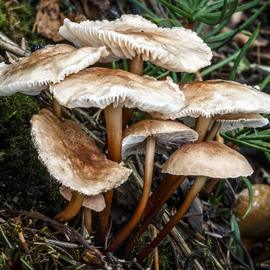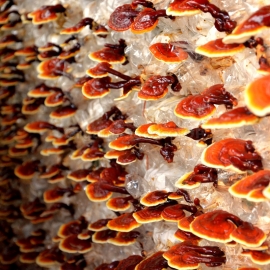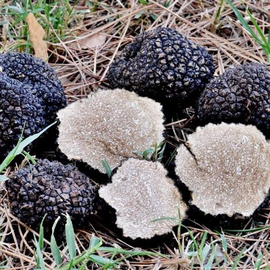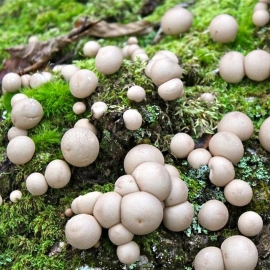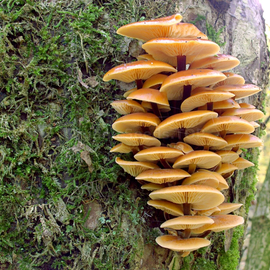 EXCLUSIVE
EXCLUSIVE
«Winter honey agaric» (Flammulina velutipes) - Organic Mushroom Spawn
6.10 €
Information about the artificial cultivation of this valuable mushroom dates back to 800-900 years. AD, the uniqueness of the winter mushroom lies in the fact that it tolerates frost well, because this mushroom is harvested frozen and thawed, the mycelium
-
Organic Mushroom Spawn «Winter honey agaric» (Flammulina velutipes)
The winter opener, or velvety flamula, is breathed by a small droplet, up to 9 centimeters in diameter, rusty-yellow color. The lower opening is central, has the shape of a cylinder, narrow, hard, yellowish brown.
Habitat
Winter mushroom grows on wood, often in hollows, under the stumps of deciduous trees - poplar, aspen, alder, willow, elm, ash, beech, oak, etc. A characteristic feature is the growth in groups. Information about the artificial cultivation of this valuable mushroom dates back to 800-900 years. ad.
Seasonality
Under natural growing conditions, winter honey agaric bears fruit from December to March. The uniqueness of the winter mushroom lies in the fact that it tolerates frosts well, therefore this mushroom is harvested frozen and thawed. An equally amazing feature is the mushroom mycelium, which can live for tens and even hundreds of years!
Useful properties and taste
Honey agaric is highly valued, first of all, for its healing properties - it is able to synthesize biologically active substances and suppress the growth of tumors. In addition, it is saturated with proteins, vitamins C and group B, and in terms of the composition of minerals, winter honey agaric has no equal among vegetable crops. Winter honey agaric is indicated for increased blood clotting, fungal diseases, allergies. Growing honey agaric in winter, you will be fully provided with a unique nutritious and healthy product.Application
From the winter honey fungus, a very tasty soup, stew is obtained, it can also be stewed, fried, pickled, salted. In a young mushroom, all the pulp is used, with the exception of dark places, and only caps are used from old mushrooms.
yield
In addition to its valuable nutritional and beneficial properties, honey mushrooms are also distinguished by high yields. Growing at home, with proper care, gives a yield of 25 to 30% of the mass of the substrate, which can be used as a wooden deck. There is also a very interesting way of planting winter mycelium in an ordinary pumpkin or zucchini. To harvest, it is necessary to keep the mycelium in a darkened room, while maintaining the humidity at 80%. Thus, growing a very valuable and useful mushroom at home will not be difficult.
Other names : winter mushroom, velvety flamulina, enokiGrowing technology
SELECTION AND PREPARATION OF WOOD:
- Suitable stumps and logs of hardwood d≥15 cm, lying no longer than 4 months after cutting, with bark and without obvious signs of infection with other fungi.
- On the day of inoculation, the log is sawn into pieces of 30-50 cm.
- From the ends and around the perimeter, in a checkerboard pattern, at a distance of 10-15 cm, holes are drilled d 1 cm, h 5-6 cm - in a log at least 20, in a stump - 40 (Fig. 1). The more sticks, the sooner fruiting will begin.
- For 2-3 days, the logs are soaked in water, and the stumps are watered (Fig. 2). Excess water is allowed to drain. Freshly sawn (up to 1 month old) wood can be inoculated without soaking.
WOOD INOCULATING:
- Stumps are inoculated in spring, logs - in 2-6 months. before disembarkation. With clean hands, the sticks are inserted all the way and the holes are closed with plasticine or beeswax (Fig. 3).
- When inoculated in August-September, the logs are immediately planted in open ground, without waiting for overgrowth.
- It is recommended to tag the log with the name and date of inoculation.
INCUBATION (OVERGROWTH):
- The log is placed in a dark damp place (basement, barn) in a black bag with holes Ø 0.5-2 cm for ventilation and tied up. The stumps are covered with wet straw (burlap) and do not allow it to dry out, or they are tied with the same film (Fig. 4).
- Under favorable conditions - a temperature of 22-26 ° C and rel. ow. air 85-90% - the log will grow somewhere in 2-3 months. At lower rates, the overgrowth period increases.
LANDING FOR FRUITTING:
- Planted in open ground from April to September, in a container - all year round *. A place for fruiting is chosen shaded and well retaining moisture.
- An overgrown log is buried horizontally in a moistened hole, covered with a 2-5 cm layer of earth on top, or vertically by 1/3.
FRUIT AND YIELD:
- Depending on the density and size of the wood, it will bear fruit for 3-7 years in spring and autumn (Fig. 5).
- When planting mycelium in the ground in the spring, expect the first harvest this year, in the summer-autumn - next.
- A mushroom grown in the fresh air looks like a chanterelle. If, within 3-5 days from the moment the rudiments of mushrooms appear, a greenhouse effect (excess CO2) is created, then its leg will be thick, and the hat will be small.
- Productivity - 15-20% of the mass of wood. Weather conditions affect the yield and appearance of the fungus.
CARE:
- It is important to maintain the moisture of the mycelium by dripping the soil around, especially in dry, hot weather. After harvesting, watering is stopped for 7-14 days.
- In summer, the mycelium is protected from direct sunlight, and for the winter it is covered from frost with foliage and earth.
With this product buy
6.10 €
The cap is yellow-brown, thin-fleshy, first convex, then flat, in the center of the cap there is a small tubercle, the plates are frequent, white-cream, adherent, the stem is cylindrical, brown, shiny, pubescent in the lower part, the flesh is thin, not b
6.10 €
Traditional and contemporary Chinese medicine admire it as a tonic benefiting vital energy or "Qi", and it is popularly prescribed for a multitude of maladies. Reishi is a polypore mushroom, growing in damp, dark forests and the occasional rotting log.
6.10 €
A genus of marsupials with underground tuberous fleshy fruiting bodies, considered valuable delicacies, in the form of irregular tubers, usually 2-12 cm in size and weighing 30-300 grams, the surface is uneven, covered with a thin velvety skin.
6.10 €
The fruiting body of a puffball mushroom develops within a few weeks and then begins to produce spores. The meat of giant puffballs tastes very similar to tofu or melted cheese when cooked. Puffballs may be sauteed, broiled, or breaded and fried.

